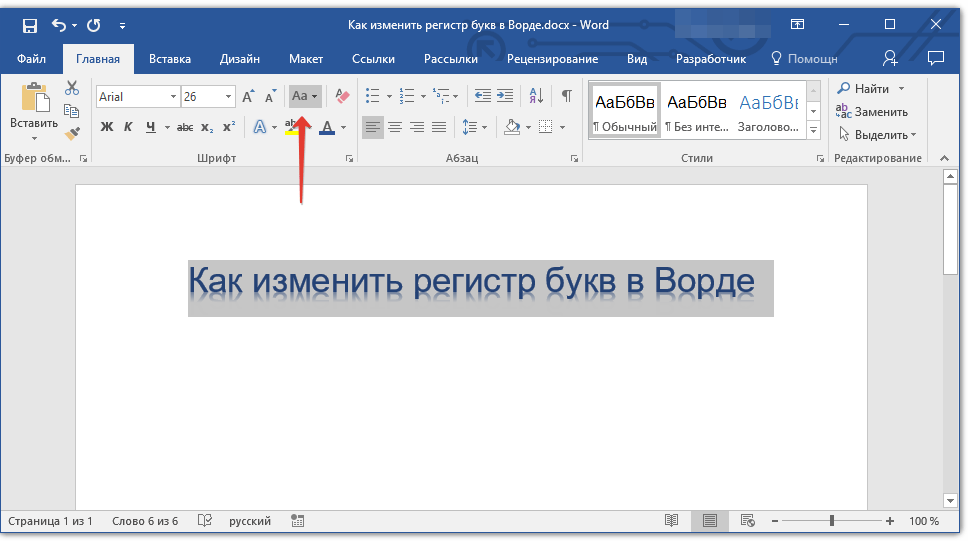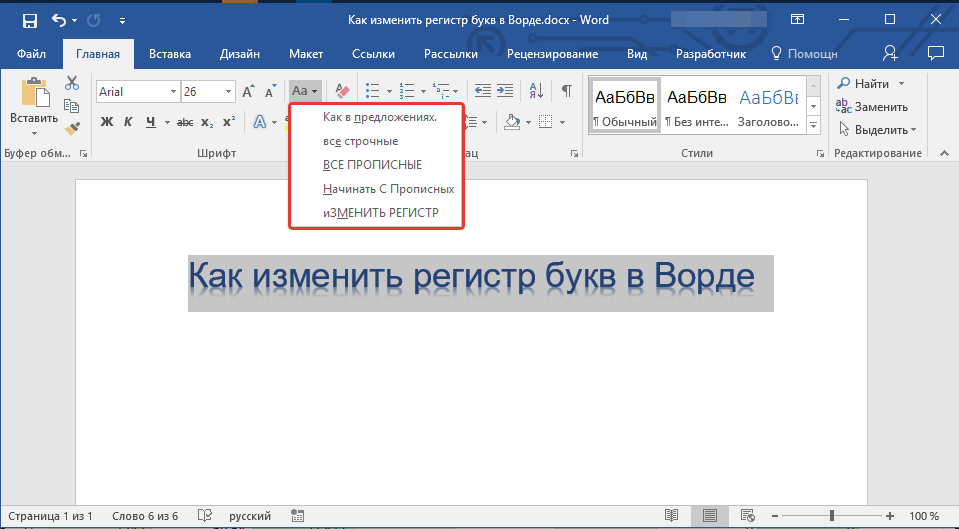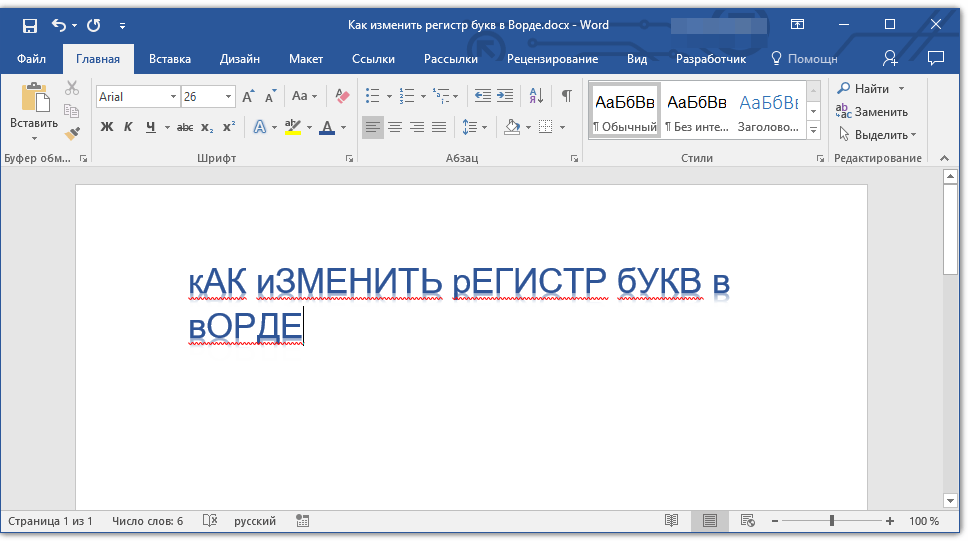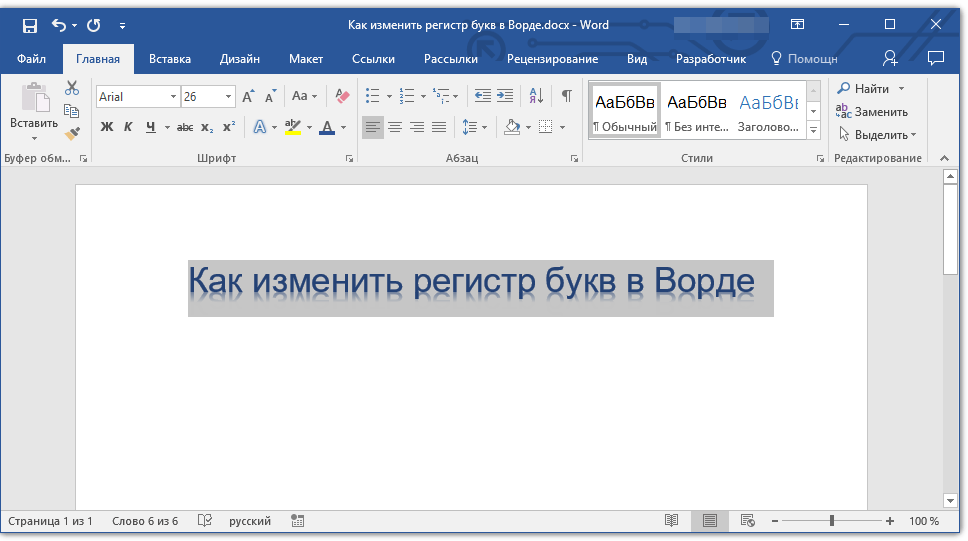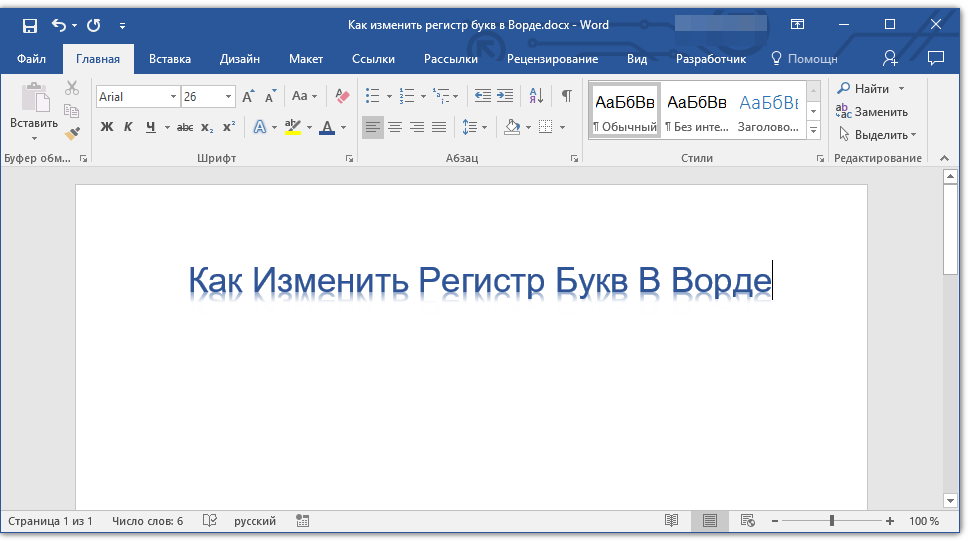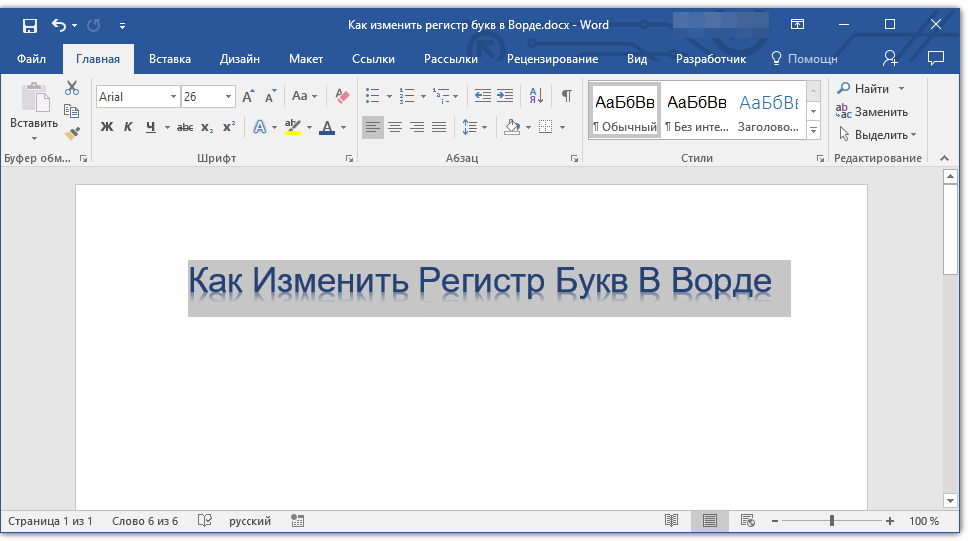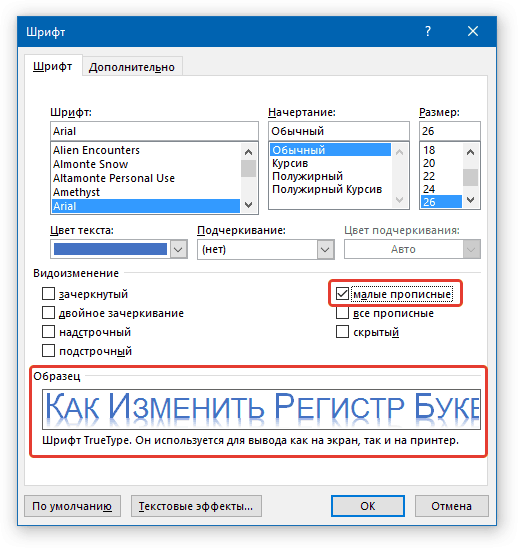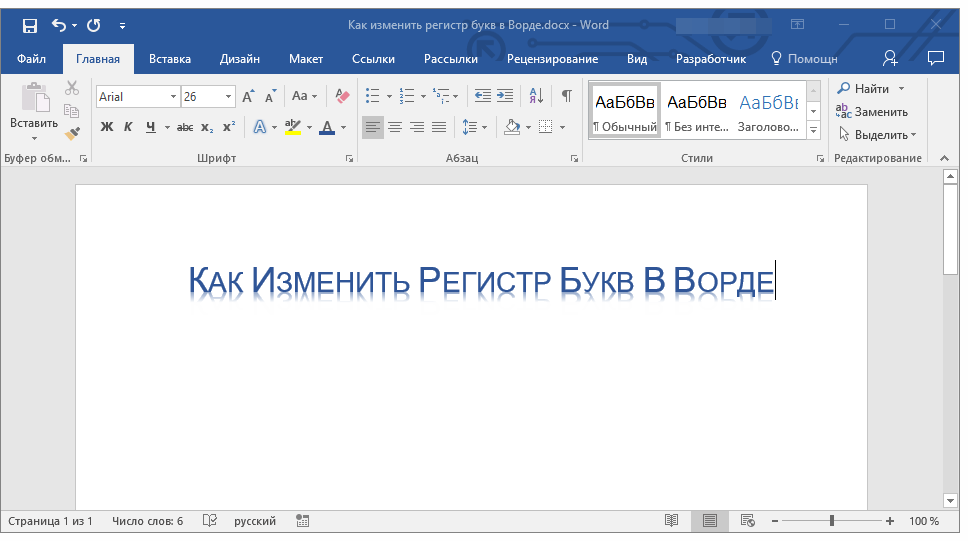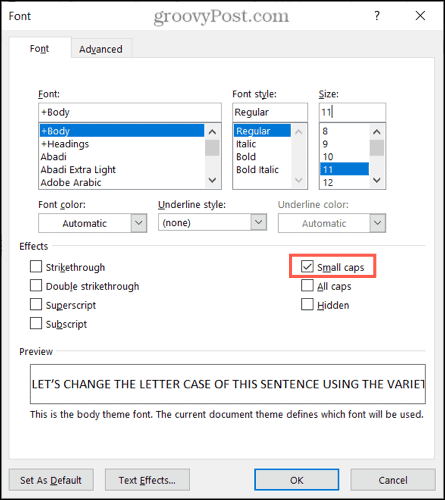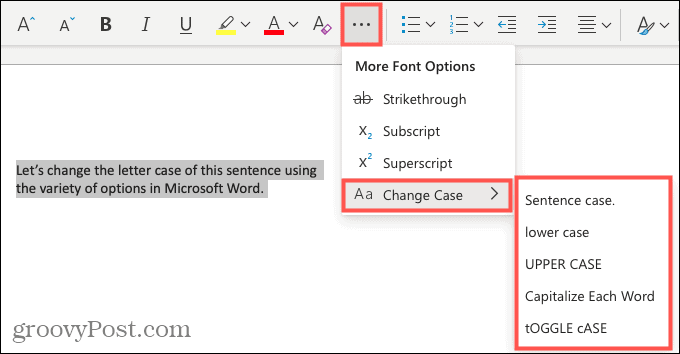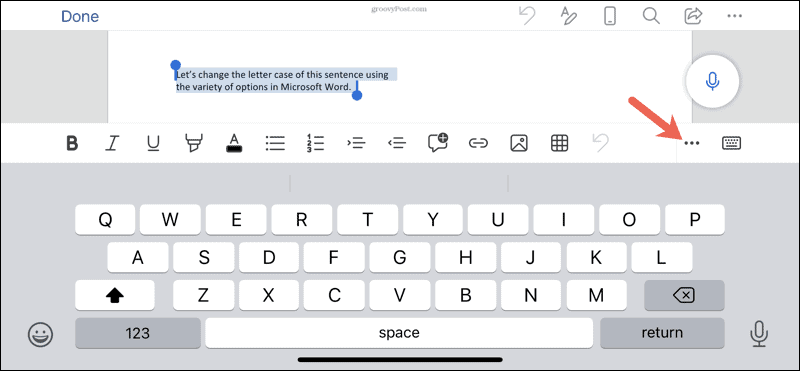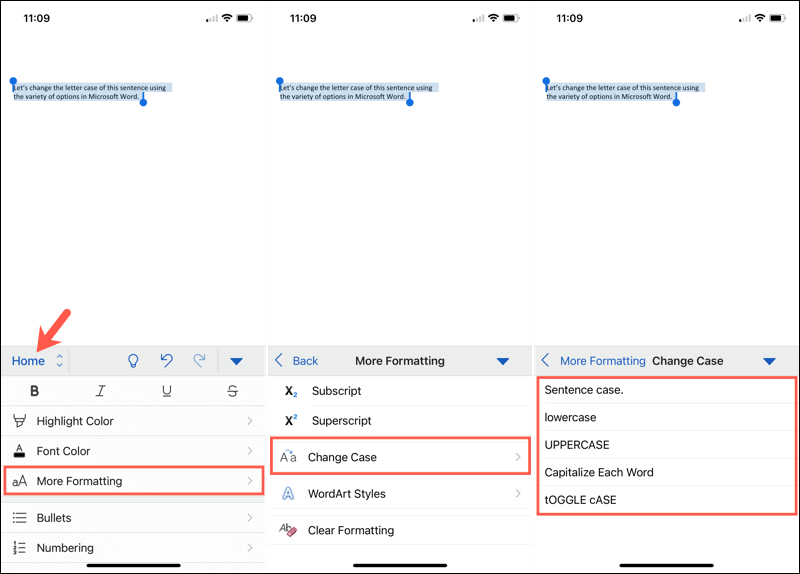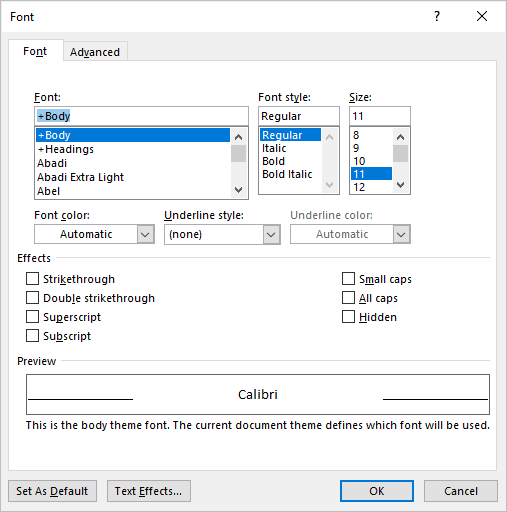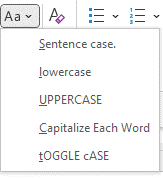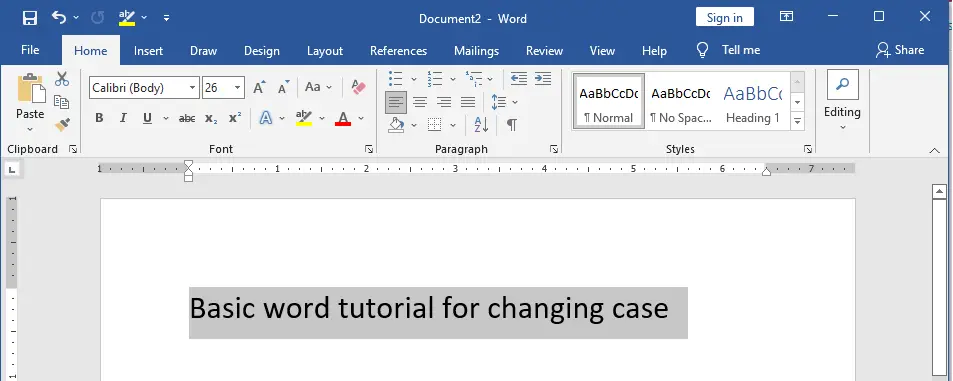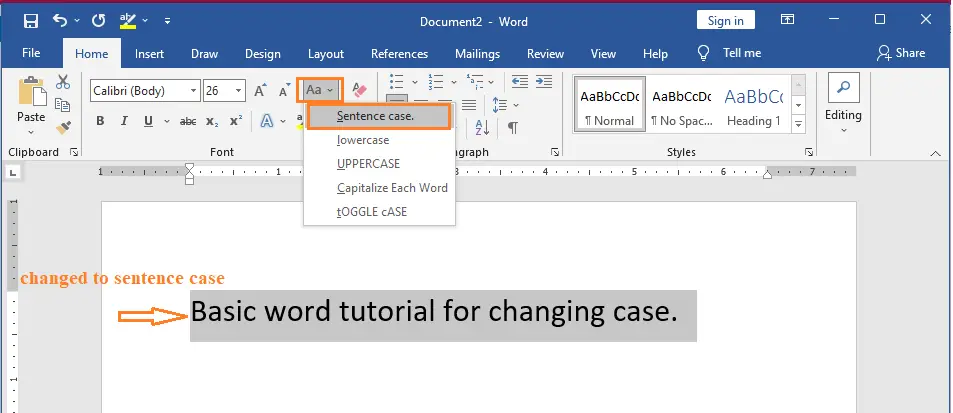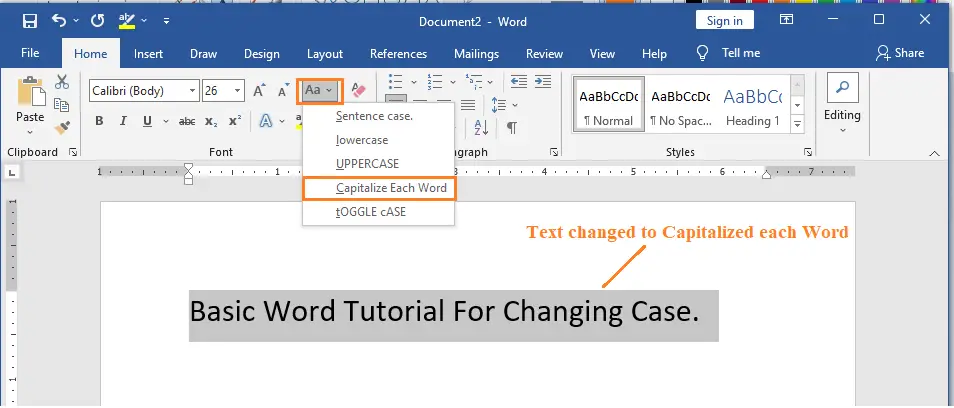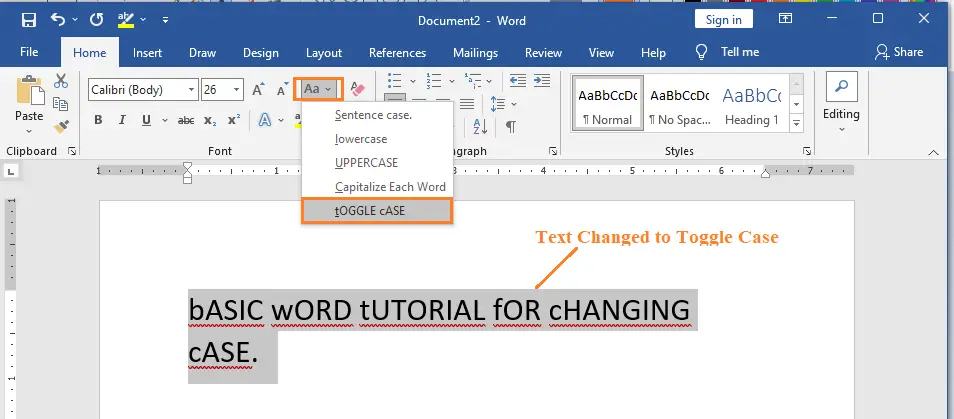You can change the capitalization, or case, of selected text in a document by clicking a single button on the Home tab called Change Case.
Change case
To change the case of selected text in a document, do the following:
-
Select the text for which you want to change the case.
-
Go to Home > Change case
.
-
Do one of the following:
-
To capitalize the first letter of a sentence and leave all other letters as lowercase, click Sentence case.
-
To exclude capital letters from your text, click lowercase.
-
To capitalize all of the letters, click UPPERCASE.
-
To capitalize the first letter of each word and leave the other letters lowercase, click Capitalize Each Word.
-
To shift between two case views (for example, to shift between Capitalize Each Word and the opposite, cAPITALIZE eACH wORD), click tOGGLE cASE.
Tips:
-
To apply small capital (Small Caps) to your text, select the text, and then on the Home tab, in the Font group, click the arrow in the lower-right corner. In the Font dialog box, under Effects, select the Small Caps check box.
-
To undo the case change, press CTRL+ Z.
-
To use a keyboard shortcut to change between lowercase, UPPERCASE, and Capitalize Each Word, select the text and press SHIFT + F3 until the case you want is applied.
-
See also
Insert a drop cap
Choose AutoCorrect options for capitalization
Change case
To change the case of selected text in a document, do the following:
-
Select the text for which you want to change the case.
-
Go to Home > Change case
.
-
Do one of the following:
-
To capitalize the first letter of a sentence and leave all other letters as lowercase, click Sentence case.
-
To exclude capital letters from your text, click lowercase.
-
To capitalize all of the letters, click UPPERCASE.
-
To capitalize the first letter of each word and leave the other letters lowercase, click Capitalize Each Word.
-
To shift between two case views (for example, to shift between Capitalize Each Word and the opposite, cAPITALIZE eACH wORD), click tOGGLE cASE.
Tips:
-
To apply small capital (Small Caps) to your text, select the text, and then on the Format menu, select Font, and in the Font dialog box, under Effects, select the Small Caps box.
Small Caps shortcut key: ⌘ + SHIFT + K
-
To undo the case change, press ⌘ + Z .
-
To use a keyboard shortcut to change between lowercase, UPPERCASE, and Capitalize Each Word, select the text and then press fn+ SHIFT + F3 until the style you want is applied.
-
See also
Insert a drop cap
Choose AutoCorrect options for capitalization
PowerPoint for the web supports changing case. See the procedure below.
Word for the web doesn’t support changing case. Use the desktop application to open the document and change text case there, or else you can manually change the casing of text in Word for the web.
-
Select the text you want to change.
-
Go to Home > More Font Options > Change case.
-
Choose the case you want to use.
Updated: 12/30/2021 by
In Microsoft Word, you can use the keyboard shortcut Shift+F3 to change selected text between uppercase, lowercase, and title case.
Selecting a case
- Highlight all the text you want to change. If you want to change the case for the whole document you can use the Ctrl+A keyboard shortcut to select everything.
- Hold down Shift and press F3.
- When you hold Shift and press F3, the text toggles from sentence case (first letter uppercase and the rest lowercase), to all uppercase (all capital letters), and then all lowercase.
Note
If you are using a laptop or an Apple Mac, the function keys may not be enabled without the use of the Fn key. You may need to hold Fn, in addition to Shift, when you press F3.
If you’re not able to get Shift+F3 to work in Microsoft Word 2007 or later, you can try the following option instead.
- In the menu bar, on the Home tab, click the Change Case icon, which has an uppercase ‘A’ and lowercase ‘a.’
- Select the appropriate option from the list of values. For example, if you want to change to all uppercase letters, select the UPPERCASE option. If you want to change to all lowercase letters, select the lowercase option.
Tip
Use our text tool to convert any text from uppercase to lowercase.
Содержание
- Изменение регистра в Ворде
- Способ 1: Кнопка на ленте
- Способ 2: Горячие клавиши
- Дополнительно: Видоизменение регистра
- Заключение
- Вопросы и ответы
Необходимость изменить регистр, в котором записан текст в документе Microsoft Word, чаще всего возникает из-за невнимательности пользователя. Например, в случаях когда фрагмент набирался с включенным режимом CapsLock, то есть прописными буквами. Также иногда поменять регистр в Ворде нужно специально, сделав все буквы большими, маленькими или просто противоположными тому, что есть на данный момент. О том, как это сделать, мы расскажем далее.
Изменение регистра в Ворде
Большинство задач, с которыми можно столкнуться в процессе использования текстового редактора от Майкрософт, могут быть решены как минимум двумя способами – с помощью кнопок на панели инструментов (лента) и горячих клавиш на клавиатуре. Справедливо это утверждение и для интересующего нас сегодня регистра.
Читайте также: Что делать, если в Ворде пропала панель инструментов
Способ 1: Кнопка на ленте
Для изменения регистра достаточно нажать всего одну кнопку на панели быстрого доступа в Word. Располагается она во вкладке «Главная» в группе инструментов «Шрифт». Так как данный элемент выполняет сразу несколько функций по части изменения регистра, будет уместно рассмотреть каждую из них.
- Выделите часть текста, для которой требуется изменить регистр.
Читайте также: Как выделить текст / абзац / страницу в Ворде
- Нажмите на панели быстрого доступа кнопку «Регистр» (Аа), расположенную в группе инструментов «Шрифт» во вкладке «Главная». Это действие откроет список доступных опций.
- Выберите в выпадающем меню кнопки подходящий тип изменения регистра:
Читайте также: Как в Ворд сделать маленькие буквы большими
Ввиду того что необходимая кнопка расположена в «Главной» вкладке текстового редактора, причем в наиболее активно используемой группе инструментов, а ее меню наглядно показывает то, как будет выглядеть текст после изменения регистра, данный способ можно назвать самым простым и интуитивно понятным. Но не единственным.
Читайте: Как в Word сделать большие буквы маленькими
Способ 2: Горячие клавиши
Действия, аналогичные вышеописанным, можно выполнить и без обращения к панели инструментов. За большинством вариантов изменения, представленных в меню кнопки «Регистр», закреплены горячие клавиши. К сожалению, их использование позволяет получить лишь три из пяти доступных вариантов написания. Таким образом можно только поочередно переключаться между тремя стилями регистра — «все строчные», «ВСЕ ПРОПИСНЫЕ» и «Начинать С Прописных», но не «Как в предложениях» и не «иЗМЕНИТЬ РЕГИСТР».
- Выделите часть текста, в которой нужно изменить регистр.
- Нажмите клавиши «SHIFT+F3» один или более раз для изменения регистра в тексте на подходящий. Изменение (для изначального текста «Как в предложениях») происходит в следующем порядке:
- ВСЕ ПРОПИСНЫЕ;
- все строчные;
- Начинать С Прописных.
- Эту же комбинацию клавиш можно применять и к отдельным буквам в словах, что особенно удобно в случаях, когда требуется изменить регистр первой буквы в предложении и/или отдельном слове.
Читайте также: Горячие клавиши для удобной работы в Ворде
Этот способ изменения регистра букв несколько проще рассмотренного нами в первой части статьи, но для кого-то отсутствие двух из пяти вариантов написания может показаться критическим, и в таких случаях не обойтись без обращения к меню кнопки «Aa» в группе инструментов «Шрифт».
Дополнительно: Видоизменение регистра
В Microsoft Word имеется еще одна возможность изменения регистра, позволяющая заменить обычные строчные буквы в словах на малые прописные. Такой стиль написания может быть применен, например, к подзаголовкам или записям в буклете.
Читайте также:
Как в Ворде сделать заголовок
Как сделать буклет в Ворде
- Выделите фрагмент текста, строчные буквы в котором требуется заменить на малые прописные.
- Откройте диалоговое окно группы инструментов «Шрифт», нажав на стрелку в нижнем правом углу.
- В разделе «Видоизменение» установите галочку напротив пункта «малые прописные».
Примечание: В окне «Образец» вы сможете увидеть, как будет выглядеть текст после внесенных изменений.
Нажмите «ОК» для того, чтобы применить внесенные изменения и закрыть окно.
- Зачеркнутый;
- Двойное зачеркивание;
- Надстрочный;
- Подстрочный;
- Все прописные;
- Скрытый.
Обратите внимание на то, что в разделе «Видоизменение» окна «Шрифт» можно определить и некоторые другие параметры написания текста, и каждый из них нами был рассмотрен в отдельных статьях. Доступны следующие варианты:
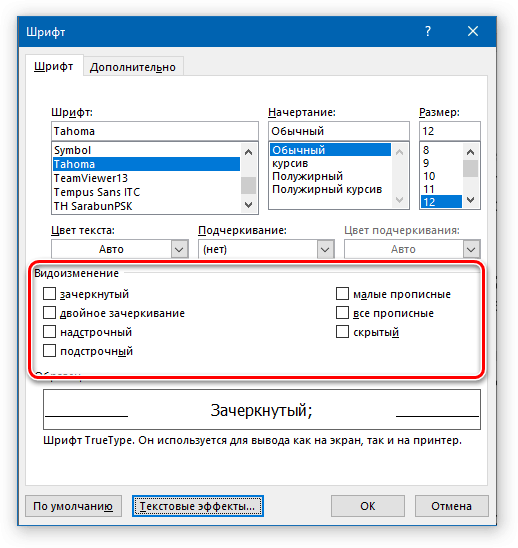
Читайте также:
Как зачеркнуть текст в Word
Как в Word поставить индекс
Как скрыть текст в Word
Как изменить Word
Заключение
Вот так просто можно поменять регистр букв в текстовом документе Microsoft Word в соответствии с вашими требованиями или с целью исправления ошибок, допущенных по невнимательности.
Еще статьи по данной теме:
Помогла ли Вам статья?
You can stop manually changing your text if you want to adjust the capitalization. We’ll show you how to easily change letter case in Word.
If you want to change the capitalization of a word, sentence, or paragraph, you don’t have to do this manually in Microsoft Word. You can easily adjust the text to all uppercase or lowercase, sentence case or toggle case, or capitalize the first letter of each word.
While not difficult to do, changing the capitalization or letter case in one fell swoop may be one of those Microsoft Word features you didn’t know existed. So here, we’ll show you how to do this in Word on your computer, the web, and your mobile device.
Change Capitalization and Letter Case on Your Desktop
On both Windows and Mac, you can make your text changes the same way.
- Open your document in Word and select the text you want to edit. You can do this easily by dragging your cursor through it, whether a word, phrase or more.
- Next, go to the Home tab and click the Change Case button in the Font section of the ribbon. The icon for the button is an uppercase and lowercase letter A (Aa).
- Select the capitalization option or letter case you’d like to use from the drop-down list. Each option shows its appearance as its name.
If you choose Uppercase and want to use a smaller version of the capital letters, right-click the selected text and choose Font. On the Font tab of the pop-up window, check the box for Small Caps and click OK.
Capitalization and Letter Case in Word for the Web
You have the same options for adjusting capitalization or letter case in Word for the web.
- Open your document in Word online and select the text you want to edit by dragging your cursor through it.
- Go to the Home tab and click More Font Options (three dots) in the ribbon.
- Move your cursor to Change Case and make your selection in the pop-out menu.
Capitalization and Letter Case in the Word Mobile App
If you use Microsoft Word on your mobile device, you’ll be glad to know you can also change the capitalization or letter case in the app.
- Open your document in the Word mobile app and select the text. You can do this by tapping a word to highlight it and, if necessary, dragging the handles to include all the text you want to change.
- Tap the three dots on the right of the toolbar above the keyboard.
- When the menu opens at the bottom, be sure Home is selected. Then tap More Formatting.
- Choose Change Case and then select the capitalization or letter case option.
Make Text Changes Easy in Microsoft Word
Little-known features like this one to change the capitalization or letter case in just a couple of clicks or taps can be a huge time-saver. You can eliminate manual typing and reduce the risk of errors when changing your text simultaneously.
For more, take a look at how to add a drop cap in Microsoft Word and how to adjust the font-kerning in a Word document.
Author:
Ellen Moore
Date Of Creation:
15 January 2021
Update Date:
13 April 2023
Content
- Change case in Word
- Method 1: Button on the Ribbon
- Method 2: Hotkeys
- Optional: Modify register
- Conclusion
The need to change the case in which text is written in a Microsoft Word document most often arises due to the user’s carelessness. For example, in cases when a fragment was typed with CapsLock enabled, that is, in capital letters.Also, sometimes you need to change the case in the Word on purpose, making all the letters large, small, or just the opposite of what is at the moment. We will tell you how to do this below.
Most of the tasks that you may encounter while using a text editor from Microsoft can be solved in at least two ways — using the buttons on the toolbar (ribbon) and keyboard shortcuts. This statement is also true for the register we are interested in today.
See also: What to do if the toolbar disappeared in Word
Method 1: Button on the Ribbon
To change case, just click one button on the Quick Access Toolbar in Word. It is located in the tab «The main» in the tool group «Font»… Since this element performs several functions at once in terms of changing the case, it will be appropriate to consider each of them.
- Select the part of the text for which you want to change the case.
See also: How to highlight text / paragraph / page in Word
- Click the button on the Quick Access Toolbar. «Register» (Aa) located in the toolset «Font» in the tab «The main»… This action will open a list of available options.
- Select the appropriate type of case change from the drop-down menu of the button:
- As in sentences — makes the first letter in sentences uppercase, all others become lowercase;
- all lower case — absolutely all letters in the selection will be lowercase;
- ALL CAPITAL — all letters are capitalized;
- Start With Uppercase — the first letters in each word will be uppercase, the rest will be lowercase
- CHANGE REGISTER — allows you to change the register to the opposite. For example, the phrase «Change Case» will become «CHANGE CASE».
See also: How to make small letters large in Word
Due to the fact that the required button is located in the «Main» tab of the text editor, and in the most actively used group of tools, and its menu clearly shows how the text will look after changing the case, this method can be called the simplest and most intuitive. But not the only one.
Read: How to make large letters small in Word
Method 2: Hotkeys
Actions similar to those described above can be performed without accessing the toolbar. For most of the change options presented in the menu, the buttons «Register», hotkeys are fixed. Unfortunately, using them only gives you three of the five available spellings. Thus, one can only alternately switch between the three case styles — «all lower case», «ALL CAPITAL» and «Start With Uppercase», but not «As in sentences» and not «CHANGE REGISTER».
- Select the part of the text in which you want to change the case.
- Press the keys SHIFT + F3 one or more times to change the case in the text to a suitable one. The change (for the original text «As in sentences») occurs in the following order:
- ALL CAPITAL;
- all lower case;
- Start With Uppercase.
- The same key combination can be applied to individual letters in words, which is especially convenient in cases when you need to change the case of the first letter in a sentence and / or a single word.
See also: Hot keys for convenient work in Word
This method of changing the case of letters is somewhat simpler than the one we considered in the first part of the article, but for someone the absence of two of the five spelling options may seem critical, and in such cases one cannot do without accessing the button menu «Aa» in the tool group «Font».
Optional: Modify register
Microsoft Word provides another casing option that allows you to replace normal lowercase letters in words with small uppercase letters. This writing style can be applied, for example, to subheadings or entries in a booklet.
Read also:
How to make a heading in Word
How to make a booklet in Word
- Select the piece of text in which you want to replace lowercase letters with small uppercase ones.
- Open the toolset dialog box «Font»by clicking on the arrow in the lower right corner.
- In chapter «Modification» check the box next to Small caps.
Note: In the window «Sample» you will be able to see how the text will look after the changes are made.
Click on «OK» in order to apply the changes and close the window.
- Strikethrough;
- Double strikethrough;
- Superscript;
- Subscript;
- All uppercase;
- Hidden.
Please note that in the section «Modification» window «Font» you can define some other parameters of text writing, and each of them was considered by us in separate articles. The following options are available:
Read also:
How to strike out text in Word
How to put an index in Word
How to hide text in Word
How to change Word
Conclusion
It’s so easy to change the case of letters in a Microsoft Word text document in accordance with your requirements or in order to correct mistakes made by inattention.
3 Ways to Change or Convert Case in Microsoft Word Documents (with Shortcuts)
by Avantix Learning Team | Updated August 1, 2022
Applies to: Microsoft® Word® 2013, 2016, 2019, 2021 or 365 (Windows)
You can change case in Microsoft Word documents by changing character formatting or by converting case. If you want to be able to easily change case (like removing All Caps), it’s best to change case by applying formatting such as All Caps or Small Caps. Alternatively, you use the Change Case command to convert case. This command offers a series of options including upper, lower, capitalize each word and sentence case. You can also use a keyboard shortcut to move through different case options.
Recommended article: How to Create a Table of Contents in Word
Do you want to learn more about Microsoft Word? Check out our virtual classroom or in-person classroom Word courses >
Change Case using the Font dialog box (apply or remove All Caps or Small Caps)
To apply All Caps or Small Caps to text as a format using the Font dialog box:
- Select the text.
- Click the Home tab in the Ribbon.
- Click the dialog box launcher on the bottom right of the Font group. Alternatively, press Ctrl + D. The Font dialog box appears.
- Select All Caps or Small Caps.
- Click OK.
The Font dialog box appears as follows:
This is usually the best way to apply All Caps since it’s a format and can be removed using the Font dialog box. You can also build this format into styles.
Change case using the Change Case command in the Ribbon
If text has been formatted with hard capitals where the user has pressed the Caps Lock key when typing text, you can remove or change the capitalization using the Change Case command. You can convert a selection typed in upper case to title case, lower case or even sentence case.
To change case using the Change Case command in the Ribbon:
- Select the text.
- Click the Home tab in the Ribbon.
- Click Change Case in the Font group (Aa). A drop-down menu appears.
- Select the desired case.
The Change Case drop-down menu appears as follows:
The following options appear in the Change Case drop-down menu:
- Sentence case – capitalizes the first letter of a sentence. If there are multiple sentences, Word will capitalize the next word after a period.
- Lowercase – removes all capitalization.
- UPPERCASE – capitalizes all letters in the selection.
- Capitalize Each Word – capitalizes each word in the selection (often called title case).
- tOGGLE cASE – shifts between two cases. For example, if the first letter of each word in the selection was capitalized, this command would switch to the opposite formatting with the first letter of each word as lower case and the other letters in upper case.
Change case using keyboard shortcuts
You can use keyboard shortcuts to move between several of the options in the Change Case drop-down menu:
- Select the text.
- Press Shift + F3. Keep pressing Shift + F3 to move between UPPERCASE, lowercase and Capitalize Each Word.
Some users may need to press the Fn key as well to activate the F3 key.
Subscribe to get more articles like this one
Did you find this article helpful? If you would like to receive new articles, JOIN our email list.
More resources
How to Create a Hanging Indent in Word (3 Ways)
How to Double Space in Word (4 Ways + Shortcuts)
10 Microsoft Word Navigation Shortcuts for Moving Around Faster
How to Keep Text Together in Microsoft Word (Words, Lines or Paragraphs)
How to Convert a PDF to Word in Microsoft Office (No Third Party Programs Needed)
Related courses
Microsoft Word: Intermediate / Advanced
Microsoft Excel: Intermediate / Advanced
Microsoft PowerPoint: Intermediate / Advanced
Microsoft Word: Long Documents Master Class
Microsoft Word: Styles, Templates and Tables of Contents
Microsoft Word: Designing Dynamic Word Documents Using Fields
VIEW MORE COURSES >
Our instructor-led courses are delivered in virtual classroom format or at our downtown Toronto location at 18 King Street East, Suite 1400, Toronto, Ontario, Canada (some in-person classroom courses may also be delivered at an alternate downtown Toronto location). Contact us at info@avantixlearning.ca if you’d like to arrange custom instructor-led virtual classroom or onsite training on a date that’s convenient for you.
Copyright 2023 Avantix® Learning
Microsoft, the Microsoft logo, Microsoft Office and related Microsoft applications and logos are registered trademarks of Microsoft Corporation in Canada, US and other countries. All other trademarks are the property of the registered owners.
Avantix Learning |18 King Street East, Suite 1400, Toronto, Ontario, Canada M5C 1C4 | Contact us at info@avantixlearning.ca
Change case
- Select the text for which you want to change the case.
- Go to Home > Change case .
- Do one of the following: To capitalize the first letter of a sentence and leave all other letters as lowercase, click Sentence case. To exclude capital letters from your text, click lowercase.
Contents
- 1 How do I change the case in Office 2016?
- 2 How do I change all caps to lowercase in Word?
- 3 How do I change caps to lowercase without retyping?
- 4 Why is shift F3 not working?
- 5 How do you change to capitals in Word?
- 6 How do you change case in word?
- 7 How do you change case in word for Mac?
- 8 What is the change case?
- 9 What is a toggle case?
- 10 How many types of change case are there in MS Word?
- 11 How do I add Change Case icon in Word?
- 12 Which of the following is a change case option?
- 13 Which menu contains the Change Case option?
- 14 How do I change F3?
- 15 How do I get my F3 button to work?
- 16 What does Ctrl F3 do in Word?
- 17 What is the use of shift F3?
- 18 How do you capitalize all letters in docs?
- 19 How do I shade a paragraph in Word?
- 20 What is title case in Microsoft word?
How do I change the case in Office 2016?
Keyboard shortcut – Shift + F3
To change text using only the keyboard, highlight the selected text, hold down the shift key and press F3. This option will toggle around three different case options: All uppercase.
How do I change all caps to lowercase in Word?
Highlight all the text you want to change. Hold down the Shift and press F3 . When you hold Shift and press F3, the text toggles from sentence case (first letter uppercase and the rest lowercase), to all uppercase (all capital letters), and then all lowercase.
How do I change caps to lowercase without retyping?
Select the text you want to change the case of, using your mouse or keyboard. On the Home tab of the Ribbon, go to the Fonts command group and click the arrow next to the Change Case button.
Why is shift F3 not working?
Shift F3 Not Working When The “Fn” Key Is Locked
2.Fn + Caps Lock. Fn + Lock Key (A keyboard key with only a lock icon on it) Press and Hold the Fn key to enable/disable.
How do you change to capitals in Word?
Change to Uppercase Using the Ribbon
- Select the text you want to change to uppercase, then go to the Home tab.
- In the Font group, select the Change Case drop-down arrow.
- Choose UPPERCASE to change the selected text to all uppercase letters.
To change the case of selected text in a document, do the following:
- Select the text for which you want to change the case.
- Go to Home > Change case .
- Do one of the following: To capitalize the first letter of a sentence and leave all other letters as lowercase, click Sentence case.
How do you change case in word for Mac?
Change text case in Word for Mac
- Select the text for which you want to change the case.
- On the Home tab, click Change Case .
- Choose an option from the menu: To capitalize the first letter of a sentence and leave all other letters lowercase, click Sentence case. To exclude capital letters from your text, click lowercase.
What is the change case?
A change case is used to define new requirements for a system or to modify the existing requirements of a system. Defining new requirements for a system indicate the likeliness of the change occurring and indicate the impact of that change. Example1: Change case to define new requirement.
What is a toggle case?
Toggle case is used when you want to automatically change the case of the text you have already typed. If you highlight a portion of text it will change all the lower case to uppercase and all lower case to upper case in one click. Just highlight the text and click on toggle case and it will change for you.
How many types of change case are there in MS Word?
Sentence case: It capitalizes the first letter of each sentence. Lowercase: It changes the text from uppercase to lowercase. Uppercase: It capitalizes all the all letters of your text. Capitalize Each Word: It capitalizes the first letter of each word.
How do I add Change Case icon in Word?
With Classic Menu for Word 2007/2010/2013/2016/2019 installed, you can click Menus tab to get back the classic style interface.
- Select the text you want to change font case.
- Click Menus tab.
- Find out the Change Case icon in the Toolbar.
- Click the down arrow next to the Change Case icon to choose the font case you want.
Which of the following is a change case option?
Using the Shift+F3 method allows you to cycle through three different case scenarios: ALL CAPS, all lowercase, and All Title Case. If you need greater control, then you need to use the menus. Simply select your text and then choose Change Case from the Format menu. Word displays the Change Case dialog box.
To change text case:
On the Home tab, click the Change Case command in the Font group. A drop-down menu will appear. Select the desired case option from the menu.
How do I change F3?
On all laptops you have to press the function (Fn) key and the f3 button to do that.
How do I get my F3 button to work?
Try Using the Toggle Key
Maybe you need to toggle before pressing F3. This is why we suggest you try combining other keys with F3 to see if that works. First of all, you need to try pressing F3 with the FN key (Function Key). If that does not work, try using Alt, Ctrl, or Shift with F3.
What does Ctrl F3 do in Word?
Ctrl+F3: Cut selected text to the Spike. You can cut as much text as you want this way and it all accumulates on the Spike.
What is the use of shift F3?
The Shift + F3 keyboard shortcut allows you to quickly change the text case of your text without having to use the button built into Microsoft Word. Select the text you’d like to change the case of or use Control + A on your keyboard to select all the text.
How do you capitalize all letters in docs?
Google Docs also includes a capitalization tool, hidden in its menus. Select your text, click the Format menu, then select Capitalization and choose the case you want. It supports upper and lower case, along with a title case option that simply capitalizes the first letter of every word.
How do I shade a paragraph in Word?
Apply shading to words or paragraphs
- Select the word or paragraph that you want to apply shading to.
- On the Home tab, in the Paragraph group, click the arrow next to Shading.
- Under Theme Colors, click the color that you want to use to shade your selection.
What is title case in Microsoft word?
Title case means that the first letter of each word is capitalized, except for certain small words, such as articles and short prepositions.
In this course, we will talk about how to change the case of text in Microsoft Word. Meanwhile, this is the continuation of the previous tutorial on how to change font style and size in Microsoft Word which are part in formatting text in your documents.
Furthermore, you can also change the case of a character you are typing by holding down the SHIFT key as you type. You can also press the CAPS LOCK key to capitalize every letter you type. Press the CAPS LOCK key again to turn off capitalization.
Table of contents
- Change Case in Microsoft Word
- What is change case in MS Word?
- Change Case Option in MS Word
- Where is the change case command in word?
- What is Title case in MS Word?
- What is sentence case in MS Word?
- How To Change Case in Microsoft Word
- Change Case in Word Shortcut
- Summary
What is change case in MS Word?
The Change Case function allows you to change the text case without having to retype it. It is the option in Microsoft word which allows us to change the case of words in the sheet. In addition, it is a command, under Font group, that converts lowercase letters to uppercase and uppercase letters to lowercase.
Change Case Option in MS Word
The following Case Options are available:
- Sentence case: Capitalizes the first letter of the first word in a sentence.
- lowercase: Makes all the letters smaller.
- UPPERCASE: Makes every letter UPPERCASE.
- Capitalize Each Word: Every word’s first letter is capitalize. This is good for headings or titles.
- tOGGLE cASE: This makes the first letter of each word smaller and all the other letters bigger.
Where is the change case command in word?
The change case command in word, cab be found in the Font group on the Home tab. Click the arrow that points down next to the “Change Case” button. It shows the menu for text case. Finally, right-click the case you want to use.
What is Title case in MS Word?
Title case means that every first letter of the word is capitalized, except for small words like articles and short prepositions. Further, only the most important words are capitalized, while the rest are written in lowercase.
In addition, the title case is often used for headlines as well, like in newspapers, essays, and blogs. It is also called “headline style” because it is often used for headlines. MS Word Tutorial for Beginners, for example.
What is sentence case in MS Word?
Sentence case is a capitalization style where only words that are capitalized are the first word of a sentence and proper nouns. Then, the rest of the words are written in lowercase.
How To Change Case in Microsoft Word
Here are the steps you need to take to change the case in Microsoft Word.
- Step 1: Choose the text you want to change.
- Step 2: If you choose Sentence Case, the text will be changed to Sentence Case.
- Step 3: Choose the lowercase option to change the text to lowercase.
- Step 4:Choose UPPERCASE if you want the text to be changed to all capital letters.
- Step 5. If you choose the Capitalize Each Word option, each word in the text will be capitalized.
- Step 6: Choose tOGGLE cASE if you want the text to be changed to Toggle Case.
Change Case in Word Shortcut
Here are the keyboard shortcut keys that is the fastest and most effective way to use the Change Case features:
- Choose the text that needs to be changed.
- By pressing SHIFT + F3, you can quickly switch between other cases.
Summary
In summary, we’ve talked about how to change case in Microsoft Word as well as what those terms mean. In addition, we know the different cases option available in Microsoft Word. We also gain insight into changing cases options step by step.
We hope this tutorial helps you as you plan to create a document in MS Word.
PREVIOUS
NEXT
Microsoft 365, Microsoft Office, Microsoft Word, Office 2007, Office 2010, Office 2013, Office 2016, Office 2019, Office 2021 / Office LTSC, Office 365 /
4 April 2022
Change Case options in Word, like many Word features goes beyond the obvious choices from the basic shortcut. There’s up to five choices on the ribbon with a keyboard shortcut to reach it.
Alter the upper/lower case of words, phrases or more. ‘change case’ can become ‘Change Case’ or ‘CHANGE CASE’ or even “cHANGE cASE” without retyping.
There are four ways to change the case of existing text in Word:
- Keyboard shortcut
- Change Case button on the Ribbon
- Alt shortcut to reach the ribbon menu.
- The Font dialog box
- Replace text – good when there’s many words or phrases to change.
Keyboard shortcut – Shift + F3
To change text using only the keyboard, highlight the selected text, hold down the Shift key and press F3. This option will toggle around three different case options:
- All uppercase
- All lowercase
- Sentence case (first letter of each sentence is uppercase and the rest lowercase)
Using the ribbon
Another way to change the case of text is to select the text that you want to change and click the Change Case button on the Font group of the Home tab on the Ribbon.

When you click the button, a dropdown menu will appear showing different options for you to choose. There are two more choices here than using Shift + F3.

- Sentence case – The first letter of each sentence in the selected text is capitalized and the rest will be lowercase. Just like these two sentences!
- Lowercase – all text will forced to lowercase.
- Uppercase – all the selected text goes to UPPER case.
- Capitalize each word – the first letter of each word will be uppercase, and the rest lowercase.
- Toggle – reverse the case. Uppercase letters become lowercase, and all lowercase letters are changed to uppercase.
Alt key sequence for Change Case
The mouse-free to reach the Change Case menu is:
Alt , H, 7 which reaches the Change Case menu list. Press S L U C or T to choose the Change Case option you want.

Using the Font Dialog Box
There are two lesser known change case options hiding under the Home | Font part of the ribbon.
The Font dialog box is under the arrow in the bottom right corner of the Font group of the Home tab on the Ribbon.

We’ve talked about those little icons many times at Office-Watch.com. Always look for them on the ribbon and click to discover a lot more choices than the basic Office ribbon offerings
There are two options for capitalization on the Font dialog box.

- Small caps – All letters will be capitalized, but letters that were already lowercase will be slightly smaller, as shown below.
- All caps – All letters will be capitalized, the same as if UPPERCASE was selected using the method described above.

These two ‘Caps’ options are different from regular Change Case choices. They change the look of the letters but don’t change the underlying Upper/lower case of the letters. Confused? It’s a bit like strikethough or superscript formatting which changes the appearance in the document, but the underlying letters haven’t changed.
NOTE: Small caps in the Font dialog box can be used in conjunction with the other two methods for changing case. Letters that would be uppercase using the other options will be slightly larger than letters that would be lowercase using the other options.
Formatting Magic with Word has a lot more tips about fonts and text formatting.
Four more vertical formatting tricks in Word
Word tables for formatting magic
All your Clear Formatting options for Microsoft Word
Make a Word text box with rounded corners

 .
.





